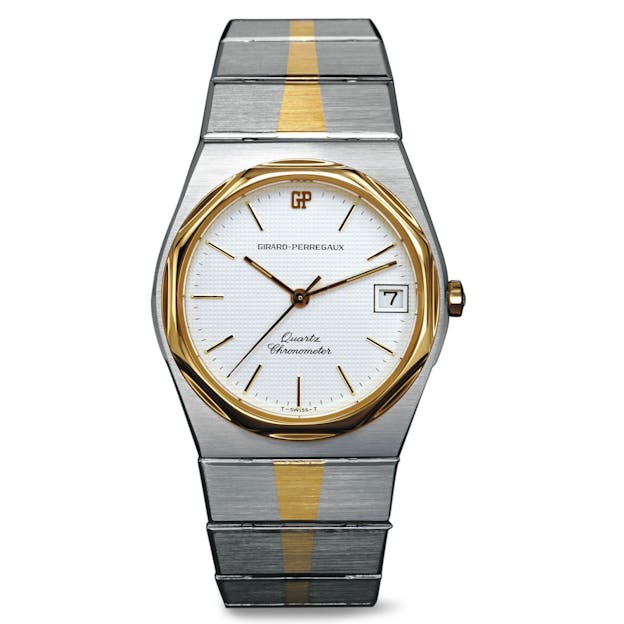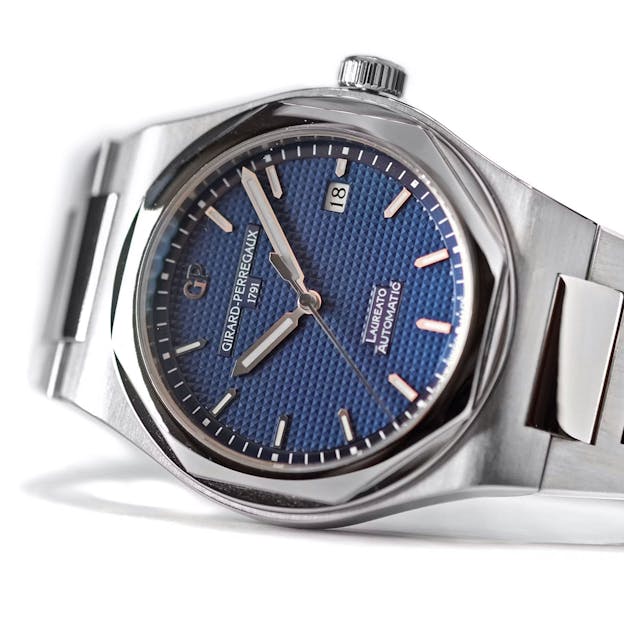A Shimmering Tribute: Horology Meets Horsepower With The New Girard-Perregaux Aston Martin Laureato
Girard-Perregaux and Aston Martin take their partnership to the next level with an iridescent green dial Laureato bringing automotive innovation to the wrist.
The worlds of automobiles and watches have long been intertwined, connected through sponsorships, collaborations, and passionate collecting communities. From legendary timepieces like the Speedmaster and Daytona to major brand partnerships such as LVMH and TAG Heuer’s involvement in Formula 1, Porsche Design’s collaborations with IWC, and IWC’s ongoing alliance with Petronas, the crossover is undeniable.

Yet, despite these deep ties, direct technological exchanges between the two industries remain rare. That is, until the Girard-Perregaux Laureato Chronograph Aston Martin Limited Edition—a watch that offers a glimpse into how techniques from automotive manufacturing can be seamlessly applied to horology.
Brief History Of The Laureato

The Girard-Perregaux Laureato debuted in 1975, embodying the unmistakable design language of ‘70s sports watches. What’s particularly interesting—at least to me—is that it actually predates other legendary steel sports watches with integrated bracelets, such as the Nautilus, the Vacheron Constantin 222, and the IWC Ingenieur. (Of course, it’s important to note that it arrived three years after the Royal Oak).
Here’s the real shocker — despite its many similarities to those previously mentioned iconic watches, the Laureato wasn’t designed by Gerald Genta. I can almost hear the collective gasp. In fact, it was Milanese architect Adolfo Natalini who crafted the design, drawing inspiration from architectural elements like the Santa Maria del Fiore cathedral (designed by Arnolfo di Cambio) in Florence. The name “Laureato” was suggested by Girard-Perregaux’s Italian distributor, referencing the Italian title of the 1967 film The Graduate (Il Laureato).
One of the Laureato’s signature design elements is the dial’s Clous de Paris hobnail pattern, a decorative technique dating back to the 18th century. However, given the model’s long production run, there are a handful of variants that forego this detail.

Since its inception, the Laureato has gone through multiple evolutions. The original 1975 model was powered by a quartz chronometer movement. The 1980’s saw the introduction of complications like chronographs and moonphases. But the biggest leap forward came in 2016, during Girard-Perregaux’s 225th anniversary, with the introduction of the ref. 81000. That 42mm model laid the foundation for the modern Laureato we know today.
Since then, the collection has expanded to include multiple chronograph variants, black ceramic cases, a range of dial colors, and even a 38mm version introduced this past year. In 2021, Girard-Perregaux embarked on a partnership with Aston Martin—bringing us to today’s release.
The 2025 Aston Martin Laureato
Housed in a 42mm grade 5 titanium case, this watch reflects the lightweight philosophy of the Aston Martins it draws inspiration from. And yes, I have to say it—under the hood is the in-house caliber GP03300. This movement, used across other Laureato chronographs, proves that Girard-Perregaux knows not to mess with a winning formula. Comprised of 435 components, it features 63 jewels, a 46-hour power reserve, and a beat rate of 28,800 vph (4Hz).

Visible through the open caseback, which is adorned with the Aston Martin logo, the movement showcases the refined details expected from a luxury timepiece. The oscillating weight and bridges feature a Côtes de Genève motif, while the movement is finished with high-quality bevelling, mirror-polished screws, and circular graining on the main plate.
The watch utilizes skeletonized hands, drawing inspiration from the signature front grill of Aston Martin’s cars. The applied indexes and subdials feature a grey-toned PVD treatment, which in my opinion work pretty well with the titanium case.
The partially open-worked hour and minute hands are coated in white lume that glows green in low light. The dial is punctuated by three snailed subdials: a 30-minute chronograph counter, a 12-hour chronograph counter, and a small seconds display.
The central chronograph seconds hand features a black tip that extends to the minute track, positioned on a raised flange around the dial’s perimeter. Completing the set of functions is the date display at the ever-debated location of 4:30.
The Dial: And A Science Lesson You Didn’t Ask For

Now, let’s get to the real star of the show—the dial. And before we dive in, consider this a preemptive apology for the science lesson you’re about to get.
The dial’s green hue (dare I call it mesmerizing?) is created through an intricate process involving 15 ultrathin layers of paint, each meticulously applied to manipulate how light is absorbed, reflected, and scattered. This isn’t just a simple paint job; it undergoes two separate heat-treatment cycles that alter the chemical structure of the paint, enhancing its depth and complexity.
The result is an iridescent effect. The color shifts depending on the angle and light source, much like how a butterfly’s wings or an oil slick produce changing hues through microscopic layers reflecting different wavelengths of light. (You have no idea how many Google searches it took to land on those comparisons.)
While this type of layering is a well-established process in the automotive world, scaling it down to a watch dial introduces challenges. At this microscopic level, even the tiniest dust particle or inconsistency can ruin the effect. To combat this, the manufacturing process includes an advanced filtration system, ensuring a flawless, uniform finish.
Depending on the light and viewing angle, the green can appear darker, lighter, or even shift slightly in hue—according to GP, it can even take on orange tinges. This dynamic quality gives the dial a sense of movement, reminiscent of how an Aston Martin’s paintwork comes alive under changing light conditions.
British Racing Green holds significant historical relevance in motorsport, as it has long been recognized as the international racing color of the United Kingdom. The shade traces its origins to the early 20th century when British race cars adopted green liveries as a tribute to Ireland. Aston Martin, like many British manufacturers, has embraced this color throughout its racing history, famously using it on its Le Mans-winning DBR1 in 1959 and continuing the tradition today with their F1 racing team.
Ultimately, at the end of the day, it’s a green dial, but I would be lying if I didn’t tell you it’s a really cool green dial that’s a wild fusion of horology and high-performance automotive design.
Quick Take
I haven’t seen this one in person yet, but I’m especially curious to test whether it really does reveal those hints of orange as GP claims. That said, I’ve always been a fan of the Laureato, and this watch only reinforces that. The partnership with Aston Martin feels authentic, not just a branding exercise, and GP has done some genuinely interesting things with the Laureato line over the years. It has that in-the-know quality—understated, refined, and appreciated by those who get it.
And because I can’t resist throwing on my contrarian hat in a world that seems to embrace homogeneity, I love that this isn’t just a green dial. GP took a risk, pushing the boundaries of what a watch dial can be, and there’s something admirable about that.
Which brings me to the thought I can’t shake when I see this dial in all its shimmering, layered, iridescent glory. I can’t help but hear that famous line from The Graduate: Mrs. Robinson, you’re trying to seduce me. And honestly? It’s working.
The Laureato Chronograph Aston Martin Edition features a 42mm grade 5 titanium case and is powered by the in-house GP03300 chronograph movement, offering hours, minutes, seconds, and chronograph functionality. Its iridescent green dial is crafted using a specialized automotive painting process, reinforcing its connection to Aston Martin’s racing heritage. Priced at $22,700. For more information visit Girard-Perregaux.

